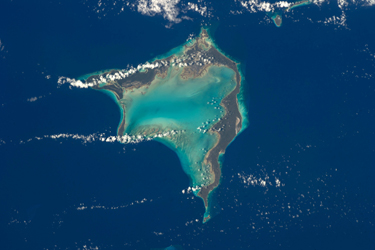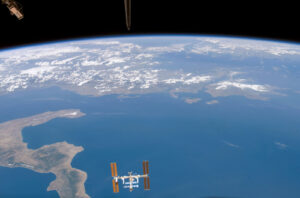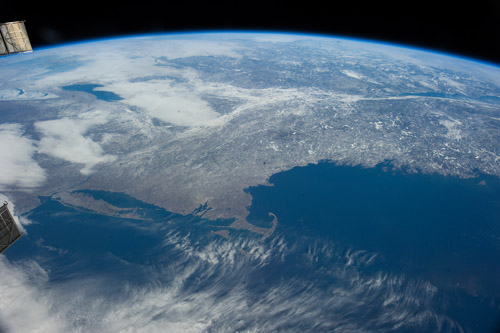
By Robert Cooke

Courtesy Dan Barstow
Some of the fun and adventure of being an astronaut comes from seeing our world from an entirely new perspective – sort of a bird’s-eye view on steroids.
During missions in orbit aboard the International Space Station, some of the space travelers get to act like avid tourists – shutterbugs turned loose in a photographic paradise. And now 20 of their choice “Windows on Earth” images are going on display in Maynard at “Gallery Seven,” 7 Nason St., right in the middle of town.
According to Stow’s Dan Barstow, who curated the show, the 20 photos are remarkable “for their beauty and emotional impact.” These are the special pictures taken by astronauts because they wanted to, not because they had to.
Of course, an important part of every mission is to return thousands of images for scientists at home to study for technical reasons. The quest involves studies in geology, geography, climate and weather, plus oceanography. But the 20 special photos being displayed at Gallery 7 are “la crème de la crème,” considered the best of the best for one simple reason – beauty.
Barstow, a 20-year resident of Stow, has long been involved in science education efforts, participating in and leading several non-profit organizations striving to keep young people interested in the adventure of science. His office is in the old Clock Tower facility, a brick colossus that was once headquarters for Digital Equipment Company.

Courtesy Dan Barstow
The photo display at Gallery 7 will last from Aug. 19 to Sept. 27, with a special reception scheduled at the gallery on Saturday, Sept. 6 at 7 p.m. The astronauts’ photo show is open to the public.
The space photos were taken with digital cameras through the Space Station’s special viewing ports, and the images were fine-tuned for color and tonality by Barstow, who was trying to capture what the astronauts were feeling artistically as they took these favorite images.
What the astronauts and cosmonauts can see and record from orbit includes the gradual shrinkage of glaciers that results from climate change, the glowing auroras above the poles, forest fires, volcanic eruptions and their long trails of ash, hurricanes, and quick bright flashes sparkling within thunderstorms.
Photo opportunities are, of course, constant. The Space Station circles our planet once every 92 minutes, offering myriad views of 16 sunrises, 16 sunsets and everything in between every day.
From the images returned, Barstow explained, “we selected 20 of the most dramatic, colorful and well-composed pictures of the Earth’s surface.”
The result, Barstow said, “is a fascinating blend of fantasy and reality.”

Courtesy Dan Barstow